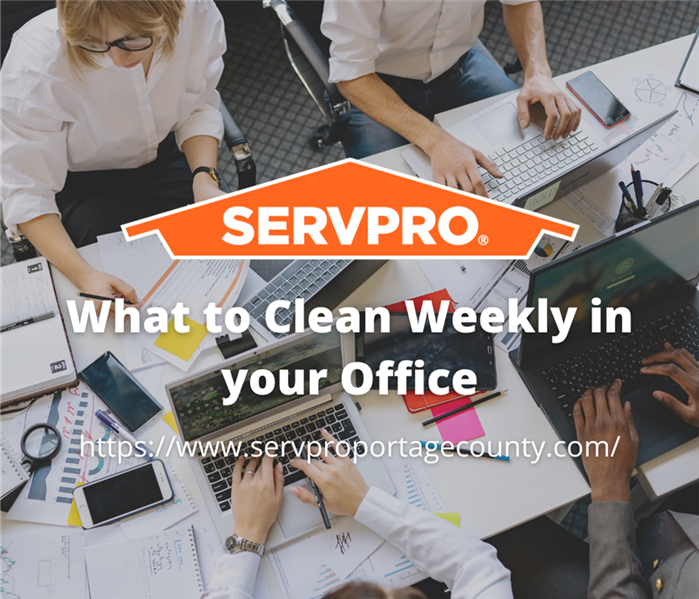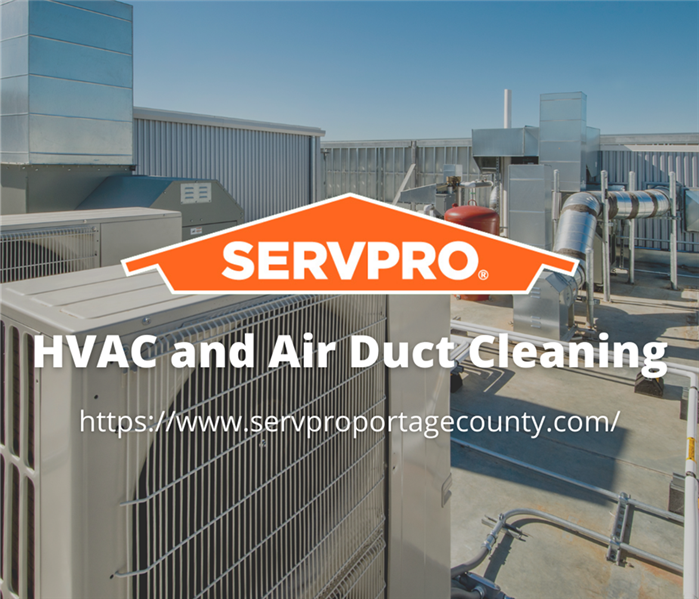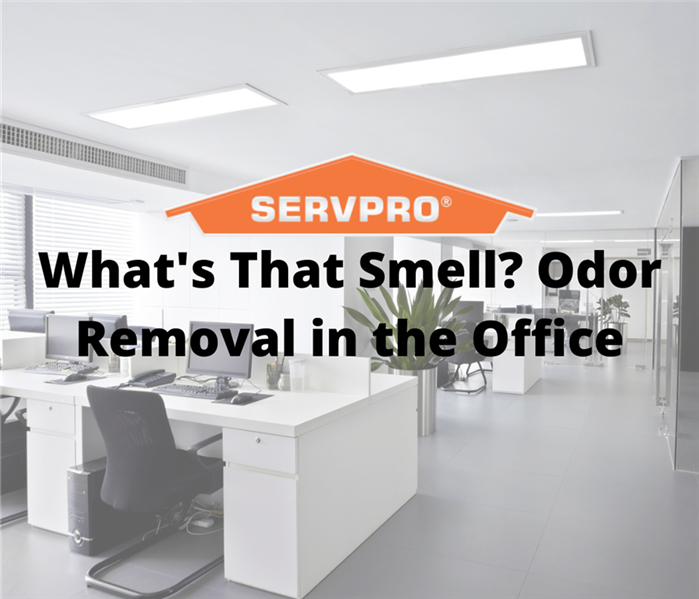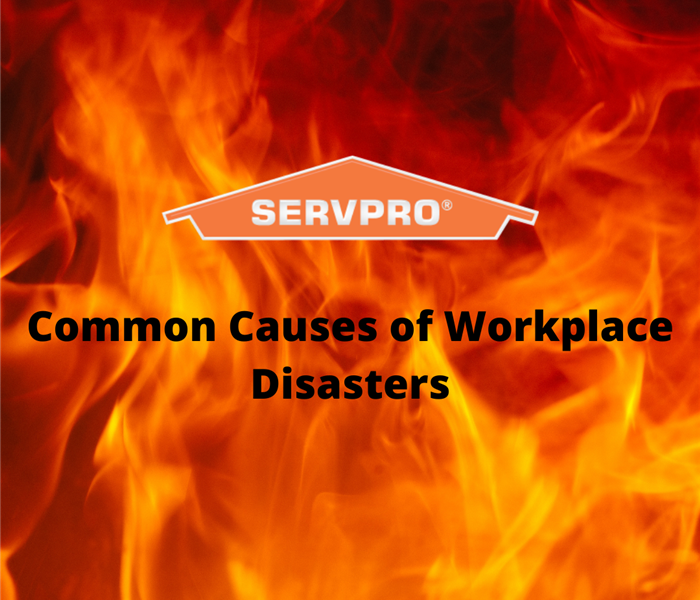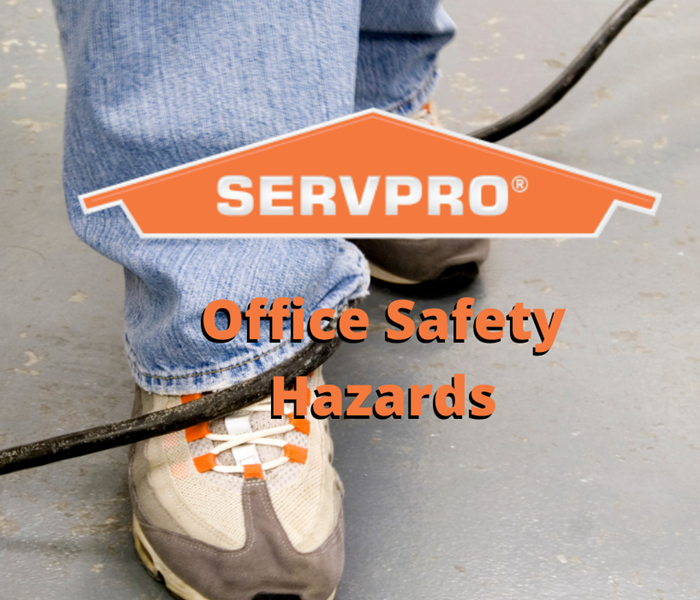Recent Commercial Posts
What to Clean Weekly in your Office
7/26/2022 (Permalink)
Cleaning your office weekly is important, especially during these COVID-19 times. Having a clean office is not only safer and healthier for you and your employees, but a clean office allows for employees to feel more comfortable, less stressed, and more productive.
Here are some things to clean in your office on a weekly basis:
- Take out trash to prevent odor and bugs.
- Clean and dust all surfaces like desks, fan blades, and shelves.
- Clean computer monitors.
- Sweep or vacuum the floors and mop every two weeks.
Having a clean office will make everyone who works there feel better. Contact SERVPRO today to see their office and commercial cleaning services.
HVAC and Air Duct Cleaning
7/6/2022 (Permalink)
Ventilation systems are often the biggest culprit in poor indoor air quality in businesses within Portage County. Make it a priority to inspect the ductwork of your business. If your HVAC has been operating for some time without attention, it could be circulating one or more of the following: dust, pollen, odors, dirt, and debris. We will get this clean and taken care of so you can have the great air quality you deserve. SERVPRO of Portage County Professionals routinely inspects the heating, ventilation, and air conditioning unit (HVAC). Keeping them clean can extend the life of the equipment.
However, duct cleaning is not always necessary. We will make recommendations about the best way to address any indoor air quality concerns. This can save you money and provide peace of mind about the health of your system.
The benefits of servicing your HVAC unit include:
- Helps to restore energy efficiency.
- Can help to eliminate offensive odors.
- Helps reduce the potential for mold growth.
How to Spring Clean Your Office
2/2/2022 (Permalink)
There’s something about spring that makes us want to clean up and start fresh. Maybe it’s the vibrant colors as trees begin to leaf and flower. Maybe it’s the warmer temperatures that wake us up from our winter hibernation. Whatever it is, the same urge follows us to our workspace, and we feel compelled to spring clean the office.
But cleaning an office space can feel overwhelming, depending on how big and how messy the office is. So here are some ways to make spring cleaning your office space less overwhelming.
Make it a team effort. Chances are you share the office with other employees. If so, then it shouldn’t fall on you alone to do the cleaning. If your colleagues aren’t so excited about a clean office, schedule a time during office hours when everyone can clean together. Assign each of them a manageable task that they can do in a short period of time. If there is a lot to do, then schedule more cleaning times, but make sure to spread them out.
Divide and conquer! Instead of cleaning the entire office, break the office into smaller sections, and clean one section at a time. For example, today you can plan to clean up one room and tomorrow the next. If you have a plan of attack, then cleaning won’t feel overwhelming. And the great part about breaking the task into smaller tasks is that you can create a list and check off the tasks as you complete them. It’s so satisfying!
As you clean, remember that cleanliness and sanitation is more important than ever. Take the time to thoroughly clean all furniture and surfaces with disinfectant. Do the same for keyboards, mouses, telephones, door handles and lightswitches. Any surfaces that get a lot of hand traffic should be thoroughly cleaned daily.
If you’re looking for a certified cleaning program that will keep your employees safe, your local SERVPRO franchise can help with the following:
Click here to find a SERVPRO near you!
Scheduled Maintenance for your Office Building
2/2/2022 (Permalink)
The condition of your office directly impacts your team’s productivity, health, and happiness. Keeping your office space clean and maintained can seem like a fulltime job in itself and requires constant attention. Taking a systematic approach to office cleaning and maintenance can not only keep your office looking presentable and functional, but save you time and money.
Scheduled maintenance is any repair and upkeep work performed within a set timeframe. It details when given maintenance tasks are performed and by who and occurs at repeating intervals. The common categories of scheduled maintenance include: Cleaning, Roofing, HVAC, Plumbing, and Lighting.
Cleaning- Cleaning tasks should be performed daily, weekly, monthly, and quarterly in order to keep your office spotless. Deep cleaning should be performed quarterly or bi-annually. In order to ensure a manageable routine, hiring a cleaning company for these tasks can be helpful.
Roofing - Should be inspected twice a year and after adverse weather conditions. Based on the inspections you may need to take action to prevent damages.
HVAC - Inspections on HVAC units should take place twice a year, and this should be performed by a professional. Air filters should be cleaned once a month or twice a year, depending on the type, be sure to find out what type you own.
Plumbing - Plumbing requires full annual inspections completed by a licensed plumber.
Lighting - Lighting usually will be pretty obvious when maintenance is required, but you can stay ahead by creating a relamping schedule. Electrical system check ups must be done by licensed electricians every 3 to 5 years.
While cleaning has always been an important and necessary part of owning an office space, COVID-19 has increased the need even further. SERVPRO offers commercial cleaning services guaranteed to keep your office looking its best. In response to the recent pandemic SERVPRO introduced, Certified: SERVPRO Cleaned, a defensive cleaning program gives your business a way forward to provide your employees and customers ongoing safety as you operate after the COVID-19 pandemic. Schedule your first cleaning appointment today and add us to your scheduled maintenance routine.
What to Do if There's a COVID Outbreak in the Office
12/28/2021 (Permalink)
As if work wasn’t already stressful enough, this year, you also have to add in company shutdowns, working from home, masks, and so much more to the list. During this time, it is important to have a plan in place in case Covid-19 comes into your workplace.
If someone is experiencing symptoms that have been linked to Covid-19, they should begin to quarantine and get tested. If an employee tests positive, it is important that anyone that had close contact* with that individual also gets tested, as well as anyone experiencing symptoms. If it is possible to work remotely it is ideal to do so for the next 2 weeks.
If an employee tested positive for COVID-19 and worked while contagious, it is recommended to thoroughly clean this space using EPA-approved disinfectants, a diluted bleach solution, or 70% alcohol solution. According to CDC, the following cleaning and disinfecting should be performed in your facility:
- Close off areas used by the person who is sick. Companies do not necessarily need to close operations, if they can close off affected areas.
- Open outside doors and windows to increase air circulation in the area. Wait 24 hours before you clean or disinfect. If 24 hours is not feasible, wait as long as possible.
- Clean and disinfect all areas used by the person who is sick, such as offices, bathrooms, common areas, shared electronic equipment like tablets, touch screens, keyboards, remote controls, and ATM machines.
- Vacuum the space if needed
Once the area has been properly disinfected, business can be reopened and workers that did not have close contact* with the infected individual can return to work. If any customers or clients had close contact with the employee, they should be notified, but you do not need to reach out to all.
The employees who tested positive or came in close contact* are able to return to work once they have both been fever free without medication for 24 hours and it has been 10 days since the onset of symptoms. If asymptomatic, 10 days after the positive test.
Stay vigilant about preventing the spread of Covid-19 by following CDC guidelines. SERVPRO can help with Covid cleaning after an outbreak, or in prevention.
*close contact is defined as being within 6 feet of an infected person for a prolonged period (15 minutes or more) starting from 2 days before illness onset. The 15 minutes does not need to be continuous. Face coverings do not eliminate all risk
Should You Update Your Company Sick Policy Post COVID?
9/6/2021 (Permalink)
Before the COVID-19 pandemic began, how many times did you go into work sick?
If you did, you are not alone, not even close. In January of 2020 - studies showed 74% of workers felt pressured to avoid taking sick days and when the survey was geared solely towards the younger generation that number increased to a resounding 88%.
It was a common theme in the workplace to only call in sick when you were basically on your deathbed and a lesser issue, such as a cold or fever, was not enough to qualify for a call-off.
Whether the reason was fear of losing your job, money, or even a promotion, people tended to go to work with mild illnesses that could in fact be contagious.
Things changed last year with the emerging pandemic. Millions of businesses were forced to close their doors to both employees and customers and move to remote work. Those able to stay open had strictly enforced regulations including temperature checks before entering the building and quarantines for being exposed to the virus.
In response to the coronavirus pandemic, Congress passed the Families First Coronavirus Response Act, which gave employees up to 80 hours of paid sick leave to care for themselves or family members. Unemployment also received huge boosts to provide assistance to those unable to work during this time.
During the pandemic businesses did not have much of a choice in the updates to their sick policies, but now that the worst has passed and vaccinations are now accessible to all, how many changes are going to be made permanent?
Many of the effects of COVID-19 were devastating and brought about negative changes, but there were also quite a few positive results. Consistent handwashing and sanitizing of hands, keeping a distance from others, being aware of contagious symptoms, and taking action when they are present are some that are positive changes to stick to.
In the workplace, it will be important to make any changes to the existing sick policy that can ensure employees feel comfortable calling off as needed. 74% of people going into work sick is not ideal and it is up to employers to bring that number down.
If possible employers should add paid sick days to their policy, as after the last year we can see that option is a lot less costly than a global pandemic.
If not possible, employers should remove call-offs for being sick from any point systems or policies that provide negative results. Keeping employees and consumers safe should continue to be a number one priority.
SERVPRO has the knowledge and training to clean and disinfect businesses to CDC standards to help maintain this level of safety. Call today to receive more information on how we can help with any post-pandemic safety needs.
What's that smell? Odor Removal in the Office
7/8/2021 (Permalink)
Did you know your sense of smell is the most powerful of them all? Well unless you are maybe gifted with a sixth sense that is. This can be both a blessing and a curse. For instance, walking into mom's house while she's baking cookies or cooking your favorite dinner, your mood may genuinely lift and you will be glad you possess the power of scent. On the other hand, if you walk into your office for an 8 hour day at the desk, and you are assaulted with a horrible sense that you can’t imagine being stuck in for 10 seconds let alone for hours, and you may start feeling edgy and crabby.
Odor can be difficult to both pinpoint and eliminate for good. While you may be able to cover it up, or air out the air, finding the source usually will require equipment and training. Odors can come from inside or outside, they can travel through vents, and have a source nowhere near where you believe it to be.
Tips to Eliminate Stubborn Odors
- Clear the Air. Allowing a regular stream of air through enclosed spaces is the first step in getting rid of bad smells.
- Open a window if possible to help.
- If unable to open windows, implement HEPA filtered HVAC filters in kitchens, restrooms, and common areas as needed
- In the Kitchen, odors will normally originate from microwaves, refrigerators, and trash cans.
- Try a fresh lemon cut in half to freshen the air
- For refrigerators, place an open box of baking soda, or opened can of fresh coffee beans in the back of the refrigerator.
- White vinegar can help with stinky trash cans, garbage disposals, microwaves, and dishwashers. For trash cans, spray down and let sit for 5-10 mins before wiping out. For microwaves, place two parts vinegar and one part water in a microwave-safe container and turn on for a couple of minutes, using a microfiber cloth to wipe inside. Two cups of vinegar on full cycle for the dishwasher, or freeze into cubes and run in garbage disposal until they are gone.
- Old carpet and furniture.
- Animal Activity, as they could be taking care of business in areas you’d rather they didn’t.
- Workplace Placement. If possible ensure workspaces are not too close to kitchens, restrooms, and other common areas where offensive odors can occur.
Odor in the workplace can be a serious issue if they persist. You may not always be able to eliminate the odor at the source on your own. SERVPRO has the training, equipment, and products to successfully rid your office of unpleasant odors, they have access to several odor removal products capable of penetrating surfaces to neutralize an unpleasant odor thoroughly. If you are dealing with this unfortunate problem call 1-800-SERVPRO today and leave the smelly stuff to the pros.
Common Causes of Workplace Disasters
4/5/2021 (Permalink)
When a disaster occurs in the workplace, mere seconds can be the difference between some extra paperwork and life-threatening situations. The main point of a workplace disaster or emergency is that you will never know when one is set to occur. This means understanding the types of disasters and what can potentially cause them is crucial.
Common Types of Emergencies
- Fires and Explosions - Fires can be caused by natural events as well as preventable accidents. Be sure to have clear safety guidelines when dealing with any potential fire hazards and enforce rules and regulations.
- Medical Emergencies - A medical emergency is unpredictable and usually hard to prevent, but you can prepare. Make sure you have relevant medical information on all staff along with individual emergency contact information.
- Severe Weather - Natural emergencies are the hardest to plan for and predict due to their very nature. A natural emergency could occur as a result of flooding, severe weather such as hurricanes or tornadoes, or forest fires. Be vigilant in watching the weather reports and listening to any and all warnings and advisories.
- Power Outages - Call your utility and report the power outage, or call 911 in case of immediate danger. Turn off and disconnect your small business’s equipment to prevent damage.
- Hazardous Material Spills - If you work with hazardous materials, it is imperative to provide your staff with proper training. Ensure everyone is aware of the potential dangers and knows how to properly handle these materials.
Knowing the common causes of workplace disasters can hopefully help to prevent any from occurring, but as there are some completely out of your control it is crucial to prepare for these worst-case scenarios to:
- Keep employees and responders free from harm
- Manage life-threatening situations
- Minimize damage to the environment, equipment, machinery, tools, etc.
- Minimize downtime
SERVPRO is faster to any disaster because we know the importance of the first few minutes following an emergency and how important it is to the outcome of such events. SERVPRO also has over 50 years of experience in biohazard cleanup and restoration after water or fire damages. Add them into your emergency response plan to make sure you minimize damages to your business if a disaster is to occur.
Top 5 Safety Investments for Your Office
2/26/2021 (Permalink)
If you’re a business owner, store manager, or office manager safety of your place of business and your staff has probably been on your mind quite a bit over the past year. It can be hard to know what to prioritize with safety as recommendations seem to change and evolve all the time. However, there are some evergreen measure you can take to ensure the safety of your workplace. Here are our top 5 recommendations:
- Invest in a high quality air filtration system.
Good air quality is paramount in keep your place of business germ and illness free. If you own your building, make sure to regularly maintain your HVAC and change your furnace filters often. We recommend using top quality allergen rated filters. If you do not own your building or have access to your HVAC system, invest in an air filtration system like a Dyson or Molecule. Make sure to purchase the system that covers your total square footage and follow the maintenance instructions to the letter.
- Prioritize scheduled cleaning and sanitizing.
Some businesses have the luxury of hiring a cleaning crew to clean common areas at regular intervals. Make sure your bathrooms, break rooms, and common areas are thoroughly cleaned and sanitized at least one per week. Encourage your staff to adopt cleaning and sanitizing practices of their own personal spaces and work stations. Incentivizing clean work spaces by offering rewards can help boost motivations to keep your offices tidy.
- Regularly police trip hazards and walkways.
One of the most common workplace injuries is falling, and coincidentally is also the easiest injury or accident to prevent. Make sure you and your staff are clearing walkways and reporting and clearly marking trip hazards identified in the workplace. One suggestion is to appoint a manager or leader to be a designated monitor of these types of hazards and create a system for reporting and then mitigating the hazard.
- Conduct a safety inspection at a regular interval.
Sometimes an outside perspective can be necessary to identify safety risks in the workplace. Many businesses conduct a quarterly or annual assessment of workplace hazards or safety risks with an outside inspector or advisor. This can also boost confidence amongst employees when they see how serious an employer takes workplace safety.
- Create written policies and review safety procedures as a group.
Every business should have clear safety protocols in the event of any disaster. All employees should be aware of these protocols and regular trainings and reminder drills can help keep safety top of mind for everyone on your staff.
Safety is an important factor in workplace satisfaction but is often not prioritized as much as it should. Investing in these simple safety strategies will not only create a safer workplace but will ultimately boost the confidence and morale of your staff as well. SERVPRO is here to help business owners implement safety protocols and mitigate safety hazards in the workplace. Contact us to learn more about our commercial cleaning services and strategies to help keep your place of business safe.
Carpet Cleaning in Your Office Is a Must
2/4/2021 (Permalink)
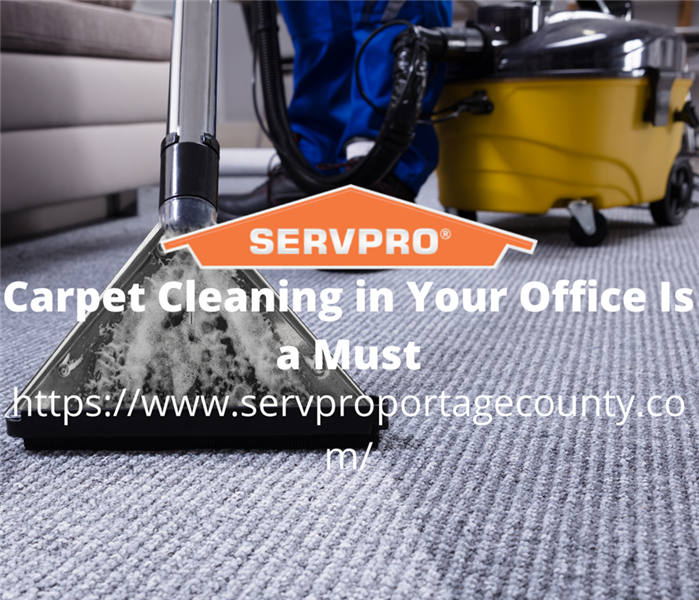 Trust SERVPRO to get your commercial carpet cleaning done right.
Trust SERVPRO to get your commercial carpet cleaning done right.
The carpets in our offices are widely used and sadly, often sparsely cleaned. Having fresh, clean carpets in the workplace offers a wide range of benefits for you and your employees, both in terms of health and functionality. Here are just a few of the many reasons you should opt for professional carpet cleaning in your business:
Allergens and Bacteria
Carpets can lay host to numerous germs and allergens that can cause potential harm to your employees. It is possible that these microorganisms can travel home in/on the shoes of your workers and invade their home life. Maintaining a regular carpet cleaning regimen for your business can work wonders in preventing the spread of these harmful substances.
Mold Prevention
A lack of proper carpet care can leave your floors at risk for serious mold damage. Mold can impact air quality and permanently damage your carpets if not treated properly. Protect your business from the harmful effects of mold damage with annual carpet cleaning treatments.
A Fresher Smell
Is there a lingering odor in your office that you just can’t seem to track down? Chances are it’s probably your carpet. Think about all of the substance we step in and thus track into the carpets with our shoes, because honestly, who is taking their shoes off before they walk into work? Getting all that funk and dirt out from your carpet with a thorough treatment will have the aura of the workplace radiating. We’re more productive when we can smell clearly!
Get Those Nasty Stains Out
Whether it’s spilled coffee, water damage, or mud tracked in from the rain; there is bound to be some staining on those office floors. This can look extremely unprofessional to customers, clients, and executive managers that visit your workplace. Carpet cleaning is a small price to pay to reflect a good image of your business.
Make sure those carpets stay clean, Certified SERVPRO Clean!
Creative PPE for your Staff
12/2/2020 (Permalink)
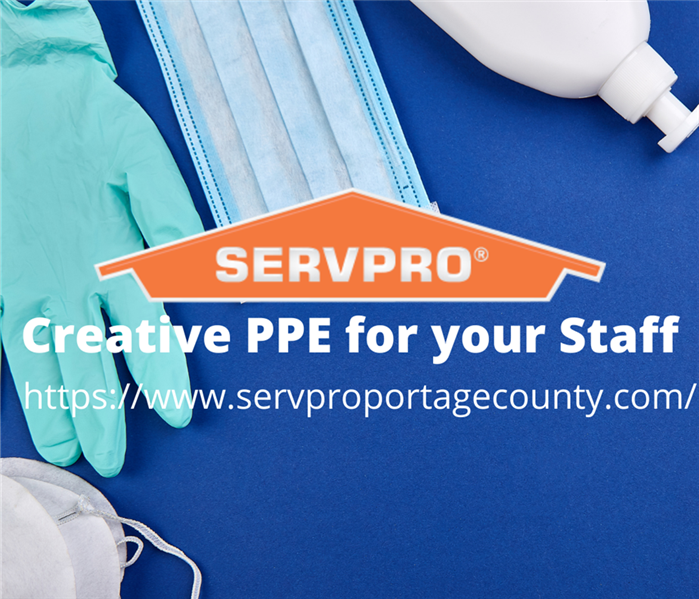 Make sure your employees are protected from any virus or bacteria.
Make sure your employees are protected from any virus or bacteria.
With a high demand for personal protective equipment (PPE) in the workplace, especially in industries that have not always required them, we are beginning to see a new level of creativity blossoming in the workplace. For those who are handy with a needle and thread, making masks is fairly easy, but not everyone is skilled in sewing. There is no need to worry, there are other avenues to take when it comes to PPE!
- Makeshift masks with layered paper towels and rubber bands
- Rubber Kitchen gloves if the store is sold out of latex gloves. Rubber kitchen gloves can even be sanitized and reused
- Well-fitting snorkel masks - an NYC physician suggested using a snorkel mask to help reduce droplet and aerosol exposure, as well as prevent touching your face!
- Make your own face shield from a hat or visor and clear vinyl from your local craft store
These ideas are just a few among many creative ways to protect yourself, your employees, and even your family. If you find that it is hard to keep personal protective equipment stocked, look into some creative avenues, and try to think of options that can be reused and sanitized.
Remember you can count on SERVPRO for any of your commercial business safety needs. We are faster to any disaster!
SERVPRO of Portage County is Your Restoration Specialist and General Contractor
9/15/2020 (Permalink)
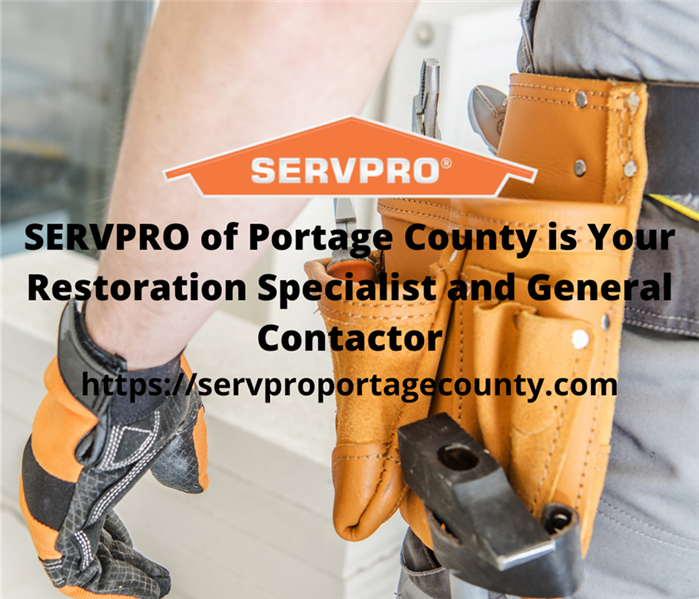 Trust a team that can restore and rebuild all together for you!
Trust a team that can restore and rebuild all together for you!
When unforeseen disasters wreck our homes and disturb our way of life, the stress and anxiety we experience is through the roof! What do I do now? Who should I call? These and many other questions are racing through our thoughts, and it can be a real hassle. What if instead of having to call multiple companies, talk to various specialists for one job and the other, we could make one phone call and have everything taken care of? Never having to experience accidental damage or disasters at home would be ideal, but things happen outside our control all the time. That’s why we are always better off prepared.
One of the biggest obstacles to project completion is poor communication. One of the easiest solutions to communication problems is to have everyone on the same team! Lots of companies offer services to contract jobs, restore and repair, but at SERVPRO of Portage County we employ contractors, disaster preparedness specialists, and restoration crews all under the same roof. What this allows is for customers to reach out in a stressful time to one of our team members, so they can relax a little while the job gets done!
Certified: SERVPRO Cleaned - A Defensive Cleaning Program
7/20/2020 (Permalink)
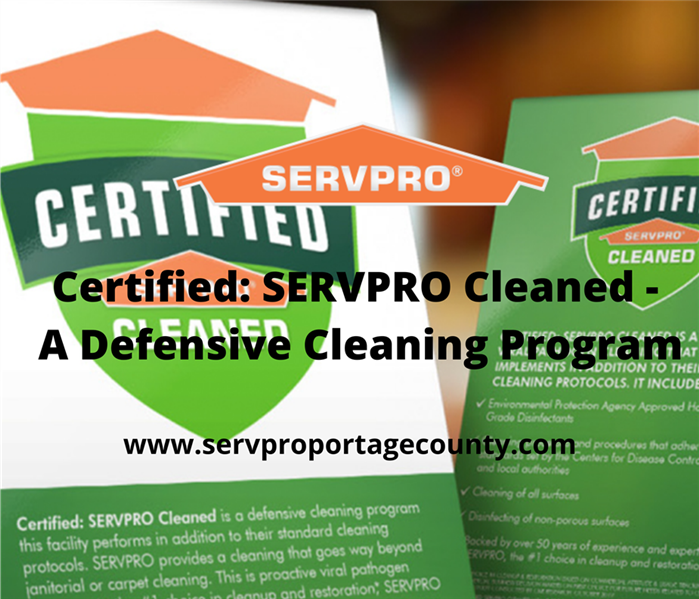 Our defensive cleaning program gives your business a way forward by providing your employees and customers ongoing safety and assuredness.
Our defensive cleaning program gives your business a way forward by providing your employees and customers ongoing safety and assuredness.
Let us help you get back to business
As our communities re-open, we’re all moving back toward a new kind of normal. The expectations of visitors, customers, and employees who come into our establishments have evolved, and staying safe and well is a top concern. The global COVID-19 pandemic has changed what it means to be clean, and we’ve developed a program to help your business meet the new higher standard of clean that is now expected.
Certified: SERVPRO Cleaned is a defensive cleaning program we’re offering to businesses and commercial locations to address the current COVID-19 pandemic. This proactive viral pathogen cleaning program goes well beyond janitorial or carpet cleaning. By choosing Certified: SERVPRO Cleaned, you, your employees, your customers, and your community can rest assured that you’ve selected a higher cleaning standard – you are Certified: SERVPRO Cleaned.
Extensive training and specialized products
As the #1 choice in cleanup and restoration*, we stand on more than 50 years of experience and expertise to help your business become Certified: SERVPRO Cleaned. Beyond fire & water, SERVPRO professionals are trained and experienced in biohazard decontamination and chemical spills – always adhering to the cleaning and decontamination standards set by the Centers for Disease Control and Prevention and local authorities.
From formulating and creating our proprietary cleaning products, like SERVPROXIDE, at our headquarters in Gallatin, TN, to taking the utmost care while disinfecting, we will ensure you and your business are set up to inspire consumer confidence as the economy continues to reopen.
3 C’s – Consult, Clean, and Certify
When the stakes are this high, you want a partner who has developed an industry leading, proprietary training program, cleaning solutions, and remediation processes over decades. We’ve cleaned up some of the most challenging biohazards imaginable. Certified: SERVPRO Cleaned reflects our unique experiences and capabilities. The program is grounded with our unique 3 C’s: Consult, Clean, and Certify.
- Consult – Every business is different, which is why you’ll be assigned a Cleaning Protocol Consultant who understands your business and will create a cleaning program to meet your specific needs. This program will be developed based on your business type, size of space, amount of high frequency touchpoints, foot traffic and congestion points.
- Clean – Based on your specific business needs, your location will undergo a thorough, deep clean, using exclusive cleaning products, according to protocols set forth by the CDC. Our employees have years of experience, and we will go beyond the scope of work that regular janitorial staff perform. Cleanup procedures generally include cleaning of porous and non-porous surfaces, disinfecting of non-porous surfaces, cleaning and disinfecting of equipment, tools, and/or supplies used for cleanup process, and disposal of hazardous materials. In the event of a suspected or confirmed COVID-19 event, we will be there cleaning within 24 hours to ensure you get back to business as quickly as possible.
- Certify - Once your business location has been Certified: SERVPRO Cleaned, you will gain access to proprietary signage, digital emblems, and other collateral that communicates that you’ve selected a higher standard of clean available to help protect your employees and customers. And because we add the day, month, and year to that proprietary stamp of clean, your guests will know that not only did you choose Certified: SERVPRO Cleaned, but that your location is being cleaned regularly at this standard.
Call today for a Certified: SERVPRO Cleaned consultation
We’re Here to Help – 24 hours a day, seven days a week – until life is back to normal in the communities we all call home.
Call SERVPRO of Portage County today at (330) 677-4483 for your Certified: SERVPRO Cleaned consultation.
* #1 Choice in cleanup & restoration based Commercial Attitude & Usage Tracking study. Polling 816 commercial business decision makers on first choice for future needs related to cleanup & restoration work. Study conducted by C&R Research: October 2019
Certified: SERVPRO Cleaned means professionally trained SERVPRO franchises perform the requested cleaning, sanitizing and disinfection services according to proprietary SERVPRO protocols and recognized industry and CDC standards with EPA approved cleaning products to deliver a SERVPRO certified cleaning experience. Each SERVPRO franchise is independently owned and operated.
Restoring Your Commercial Property After A Water Damage Event
4/4/2020 (Permalink)
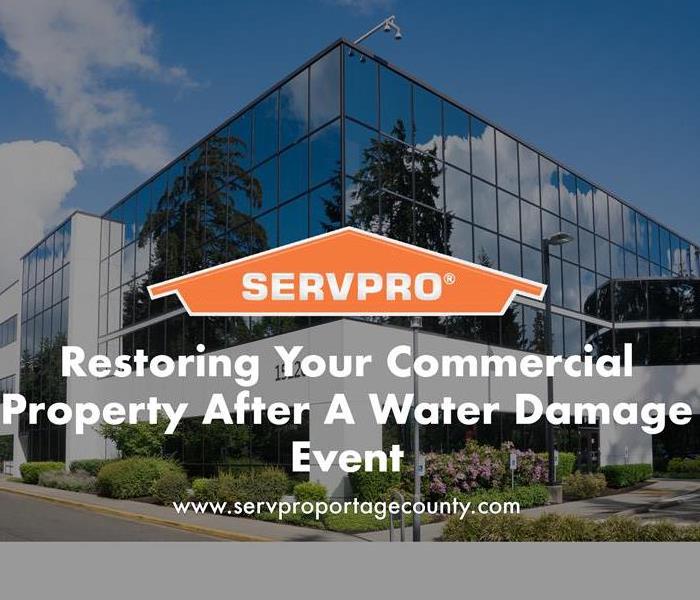 It is important to plan ahead for your business whenever possible.
It is important to plan ahead for your business whenever possible.
Flooding and water damage events in Portage County businesses are often complex that require a knowledgeable and flexible response. Having any sort of damage to your business is stressful. Whether it’s a relatively small water cleanup or a large scale event, we work quickly to assess each unique situation.
Our professionals are trained to fully restore the damaged area while working within your budgetary constraints. We understand that every hour spent cleaning up is an hour of lost revenue and productivity.
Therefore, when an emergency situation arises in your business, give us a call and we’ll be there fast with professional help and restore your business damage efficiently, so you can return open your business doors again.
It is important to plan ahead for your business whenever possible. We know how devastating business disasters can be, but we are here to help! Call SERVPRO of Portage County (330) 677-4483 to help get your Emergency Readiness Plan in place.
Flooding Tips for Commercial Buildings in Portage Ohio.
3/4/2020 (Permalink)
 Call SERVPRO of Portage County (330) 677-4483 to help get your Emergency Readiness Plan in place.
Call SERVPRO of Portage County (330) 677-4483 to help get your Emergency Readiness Plan in place.
Flooding occurs in the Northeast Ohio area and is ranked as one of the most common natural disasters in the United States. On average, floods cost $6 billion in annual losses. Flooding can result from weather, plumbing failures, frozen pipes or even damaged structures. SERVPRO of Portage County is the company that will help get your building restored in a timely manner.
However, being prepared with potential flooding in advance can affect how much of your property can be restored:
- Determine if your property is in a floodplain. This is an area of low-lying ground adjacent to a river.
- In any emergency, listen to the local management officials
- Assess how your business functions, both internally and externally.You can do this easily by signing up for our Emergency Readiness Plan; this will help your business prepare in case of an emergency.
- Plan what you will do if your building is not accessible. This type of planning is often referred to as a continuity of operations plan.
- Review your emergency plans annually. Just as your business changes over time, so does your preparedness needs. You can put together an Emergency Plan with our Emergency Readiness Plan.
It is important to plan ahead for your business whenever possible. We know how devastating a business disasters can be, but we are here to help! Call SERVPRO of Portage County (330) 677-4483 to help get your Emergency Readiness Plan in place.
Nine Preparation Tips For a Businesses Disaster
2/5/2020 (Permalink)
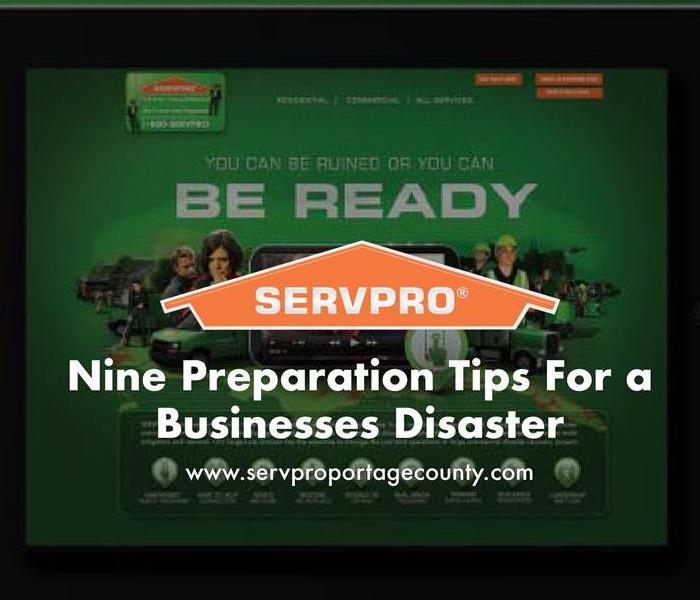 We know how devastating a business disaster can be, but we are here to help! Call SERVPRO of Portage County
We know how devastating a business disaster can be, but we are here to help! Call SERVPRO of Portage County
Would your business be ready to handle a catastrophe? A disaster can hit at anytime, whether it’s for a natural disaster, a man-made hazard, or a large-scale utility disruption. That’s why preparation for a disaster is critical.
Here are tips for disaster preparation and recovery:
1. Make a plan: If you don’t have a plan for business disaster recovery, create one today. SERVPRO of Portage County can help you create this plan for no cost.
2. Involve all employees: Your workforce is your most valuable asset therefore it’s important to educate everyone in the planning, communication, and implementation of your Emergency Readiness Plan. You never know when the disaster can hit.
3. Promote communications: It is important to know who to contact for workforce, business partners, construction services, and insurance companies. Make sure that your contact lists are regularly updated.
4. Evacuation procedures: If you are forced to abandon your business, you will need an alternative location to carry on your business. Ensure that employees know the drill for evacuating your buildings, and identify a second site from which operations may resume.
5. Assess your business assets: You should conduct an audit of facilities and equipment to establish how they may be kept secure in the event of a disaster.
6. Backup essentials: Make sure to keep alternative supplies ready. Some of these items are essentials for power, communications, and first aid.
7. Organize cash flow: Figure out extra resources to handle unforeseen expenses. It is important to also determine which employees will have access to emergency funds.
8. Review your insurance: Does your policies cover areas such as fire and water damage? Discuss essential emergency information with your insurance agent.
9. Practice your plan: Do a few trial runs of your company’s emergency drills. You will want to rehearse and test your contingency plan regularly, and update it as needed.
None of us likes to contemplate the aftermath of a business disaster, but the truth is we also need to prepare for the worst; disaster can strike at anytime.
We know how devastating a business disaster can be, but we are here to help! Call SERVPRO of Portage County (330) 677-4483 to help get your business restored efficiently.
The SERVPRO Emergency READY Profile Advantage
12/2/2019 (Permalink)
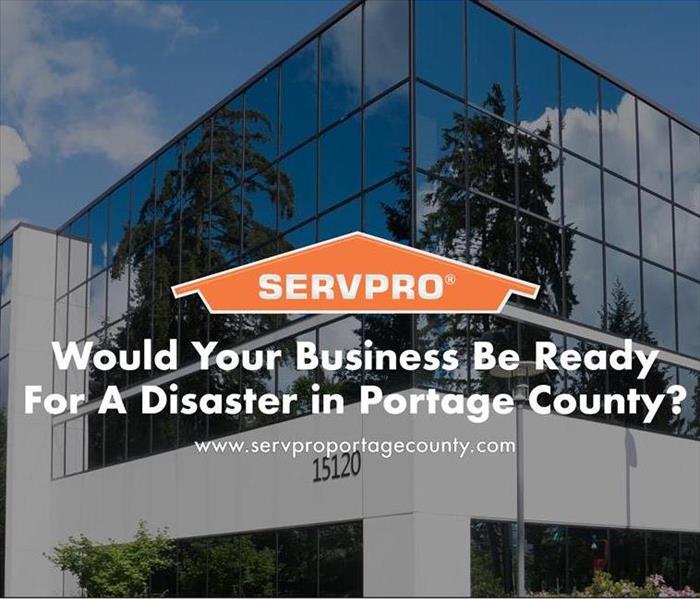 We know how devastating a business disaster can be, but we are here to help! Call SERVPRO of Portage County (330) 677-4483.
We know how devastating a business disaster can be, but we are here to help! Call SERVPRO of Portage County (330) 677-4483.
As many as 50% of businesses close down following a disaster, according to the latest research. Of the businesses that survive, the overwhelming majority of them had a preparedness plan in place. Pre-planning can serve as an insurance policy aimed at peace of mind. And knowing you are "Ready for whatever happens" speaks trust to your clients and employees that in the event your business is affected by a disaster, they don’t necessarily have to be.
By developing a SERVPRO Emergency READY Profile for your business, you minimize business interruption by having an immediate plan of action. Knowing what to do and what to expect in advance is the key to timely mitigation and can help minimize how water and fire damage can affect your business.
- A no cost assessment of your facility.
This means there is no need to allocate funds, giving you a great value at no cost.
- A concise Profile Document that contains only the critical information needed in the event of an emergency.
It will only take a little time to complete and will not take you away from current projects. But it will save a lot of time if ever needed.
- A guide to help you get back into your building following a disaster.
This can help minimize the amount of time your business is inactive by having an immediate plan of action.
- Establishes your local SERVPRO Franchise Professional as your disaster mitigation and restoration provider.
You have a provider that is recognized as an industry leader and close by.
- Identification of the line of command for authorizing work to begin.
This saves time so we can begin the work of mitigating the damage which can save you time and money.
- Provides facility details such as shut-off valve locations, priority areas and priority contact information.
Having a quick reference of what to do, how to do it and who to call provides solutions in advance of an emergency so that during the emergency you are "Ready for whatever happens."
We know how devastating a business disaster can be, but we are here to help! Call SERVPRO of Portage County (330) 677-4483 to help get your home restored efficiently.
SERVPRO of Portage County sewage back up cleaning for commercial buildings is ECO-Friendly and Sustainable.
10/9/2019 (Permalink)
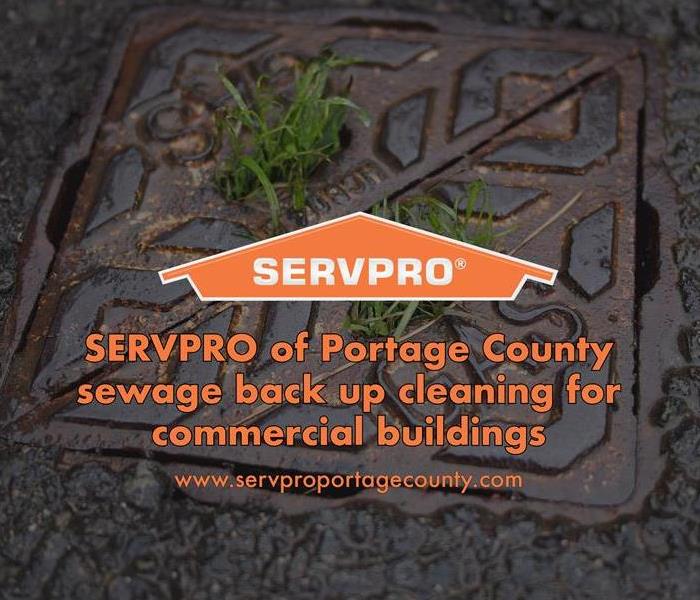 One of the most unhealthy situations for a business is backed up sewer water.
One of the most unhealthy situations for a business is backed up sewer water.
One of the most unhealthy situations for a business is backed up sewer water. Sewage is considered biohazard and carries many bacteria and germs. Even worse, you can spread that bacteria by improper cleaning procedures. As sewage professionals, SERVPRO has the proper gear to prevent exposure. If this has happened to you, we know that every minute counts. You may be tempted to handle your sewage situation yourself, but we highly advise that you call a professional for sewage backup cleaning.
When it comes to sewage backup cleaning, time is of the essence. Without the proper tools and equipment, the cleanup process can go on forever. SERVPRO of Portage County can provide sewage backup cleaning that is efficient and green. Some companies use industrial-grade artificial disinfectants, these harsh chemicals leave behind a harmful residue in the environment. That’s why SERVPRO uses Benefect instead, it is an industrial grade authentic botanical disinfectant that’s powerful enough for sewage but made from natural, safe ingredients. “Benefect products use Thyme Oil that has been specially grown & blended to exacting specifications. This groundbreaking botanical technology is proven to kill over 99.99% of bacteria and surpasses the U.S. Environmental Protection Agency's efficacy requirements for broad spectrum hospital disinfectants”. www.benefect.com
With over 30 years of experience, you can trust that SERVPRO of Portage County will follow mandated regulations and safety standards. In fact, we are a preferred vendor for many local and national businesses. We are IICRC certified, insured and have the resources to return your business to a safe and healthy environment in the most efficient manner possible.
Call anytime – 24 hours a day / 365 days a year – someone is waiting to discuss your unique situation and help you determine the best course of action.
How to Plan for A Disaster In Your Business Before it Happens
10/4/2019 (Permalink)
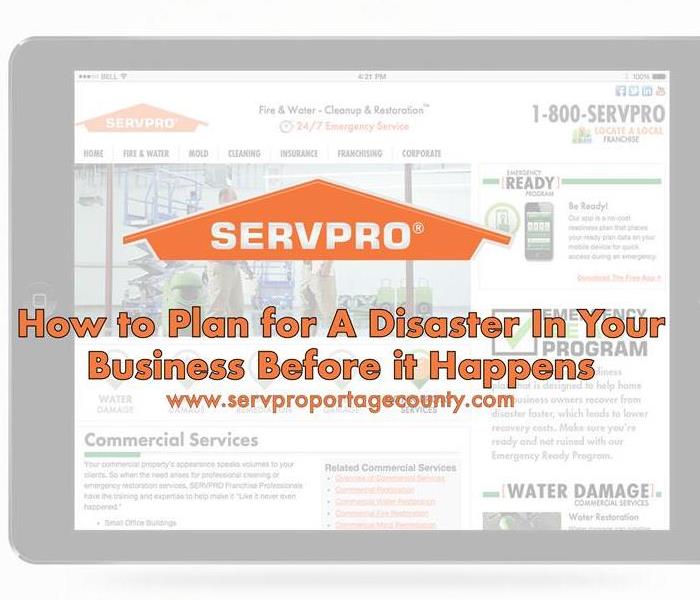 SERVPRO's Emergency Ready Profile for YOUR business will minimize business interruption by having an immediate plan of action
SERVPRO's Emergency Ready Profile for YOUR business will minimize business interruption by having an immediate plan of action
Damage from fire, storm, or water can happen at anytime and affect your business. The best way to reduce business interruption following a disaster is to PLAN for it as much as you can.
The statistics uncovered by industry research say as many as 50% of businesses may never recover following a disaster. Of the businesses that survive, the majority had a preparedness plan in place. There are a lot of ways to have a plan in place so you can get back to operation in your business.
SERVPRO's Emergency Ready Profile for YOUR business will minimize business interruption by having an immediate plan of action; you might not be prepared for the disaster but with a ready profile you will have a plan on how to act. With a no cost assessment of your facility, the program's profile includes your emergency contacts, all shut off valves and their locations, priority areas of your facility and so much more. All of these things are critical so that you can take action effectively.
The SERVPRO Ready Plan provides solutions in advance of an emergency so that during the emergency you are "Ready for whatever happens.” Businesses have raved about how much time was spent when disaster hit because of their action plan. They also have said that it helped get their business restored in an effective amount of time.
Your business will receive the benefit of over 40 years of experience in reducing the impact of any natural or man-made disaster. Call SERVPRO of Portage County at (330) 677-4483 and take the next step in protecting and growing your business.
And now with the SERVPRO Ready Plan Mobile App, help is at your fingertips. Call now and ask how to get started.
Be Prepared With Your Emergency Ready Profile (ERP) in Portage County
7/26/2019 (Permalink)
 When disaster strikes, having this tool in place will allow you or any employee to effectively handle whatever arises.
When disaster strikes, having this tool in place will allow you or any employee to effectively handle whatever arises.
You may be asking, “What is an ERP?” An Emergency Readiness Plan or Emergency Ready Profile is a method of careful, well-practiced strategy of planning for emergencies before they happen to prevent panic during a catastrophe.
With SERVPRO's Emergency Ready Profile (ERP), you minimize business interruption by having an immediate plan of action at no cost in Portage County.
What should your ERP contain? Besides the essential information such as emergency and primary contacts, gas and water shut-off areas, and priority areas and procedures, the Department of Homeland Security refers to your ERP as “Protective Actions for Life Safety” which includes:
- Fire Drills -- Rehearsing the action to take during a fire.
- Shelter -- Sheltering staff during a natural disaster.
- Shelter in Place -- Sheltering staff during a man-made emergency.
- Lockdown -- Eluding and protecting against an active shooter
You will have peace of mind using SERVPRO’s Emergency Ready Profile. Plus, our mobile app Ready Plan allows for instant share and quick accessibility for assistance. Rest assured, your business is in good hands when you trust SERVPRO and our highly, well-trained professionals.
Emergencies do not wait for you, so do not wait to be prepared. With SERVPRO of Portage County in your pocket 24 hours a day, 7 days a week including holidays and weekends, we will get your commercial property taken care of. When disaster strikes, having this tool in place will allow you or any employee to effectively handle whatever arises.
Back to Basics: 6 Steps to Handle Large-Loss Fire Restoration
4/2/2019 (Permalink)
Not only can a fire be devastating for the structure of a home or building, but it can also be emotionally devastating when it comes to the occupants of that structure, whether that is a family of four or a company of 400 workers. That's part of the reason why handling a large-loss fire doesn't just involve restoring the property to a preloss condition, but also being sensitive and understanding with the occupants of the affected home or business.
That's not to say that restoration professionals are counselors — they're not — but acting with empathy can go a long way toward making a fire loss a little less stressful for the individuals who are most impacted.
Here are six steps to follow to handle large-loss fires:
Getting the call: Whether this initial call comes from a homeowner or the insurance company, this first point of contact is an ideal time to gather as much information as possible about the fire. Where did it occur? How many rooms are affected? What type of fire was it? The goal of this initial point of contact is to gather information to get an idea of the scope of the project before arriving on site.
Arrive on site/inspection: After the initial phone call comes an on-site inspection. This is typically done after the fire department has doused the flames and secured the property. By this point, the restoration team should have a good idea of what type of fire occurred (i.e. protein fire, petroleum fire, etc.) and inspecting the property helps team members estimate the scope of work that will be involved, the timeline of the project and whether or not any demolition and reconstruction will be necessary. Depending on the severity of the fire, the restoration team may also board up the windows and doors to ensure structural stability.
Access occupant needs/packout: If it is possible, restoration professionals will likely ask the building occupants to gather any immediate needs. For a house fire, this may consist of undamaged clothes, school supplies, computers, etc. Everything else in the facility that has been affected by the fire will then likely be packed out and taken to an off-site location for contents restoration.
Estimate and begin work: After estimating the cost of the project and having the proper documents signed by all parties involved, then work can start on the fire loss. For a large fire loss, demolition and reconstruction of at least a portion of the property is likely necessary. Other areas of the property may just require soot and smoke damage restoration, where walls are HEPA (high-efficiency particulate air) vacuumed and washed, items are hand-cleaned and carpets are deep cleaned to remove soot residue. While restoration is occurring on site, it's also likely occurring off site in terms of the packed out contents (i.e. affected clothes, electronics, hard items, soft goods, etc.).
Frequent communication: Whether the project takes five days or five weeks, good restoration contractors will be in regular communication with both the insurance company and the homeowner or business owner. This constant communication helps keep all parties up to date on progress, as well as provides an outlet for questions to be asked and answered related to the project. Communication is often the differentiating factor between good and poor restoration contractors, as keeping in regular touch with relevant parties ensures transparency and provides a regular source of contact.
Final jobs/walk-through: After the crux of the project is complete, the last step is usually having the air ducts professionally cleaned and deodorized so soot doesn't contaminate — or cross contaminate — the facility. Following this, the occupant and insurance adjuster will likely take a final walk-through of the property to ensure the job has been done adequately and correctly. Any contents that went off site for cleaning will also be returned to the home and placed in their original location.
As you can see, a large-loss fire restoration job is a bit of a different challenge compared to a standard water damage restoration or mold remediation job. It's important your crew is trained to properly handle all the steps of every unique job.
Advanced Planning Ensures Experienced Partner Before Disaster Strikes
4/2/2019 (Permalink)
Thousands of commercial and industrial buildings each year are damaged by unforeseen disaster, ranging from fire or smoke and soot to water that infiltrates walls, floors, and equipment through events such as a burst water pipe, seepage, fire sprinkler flooding or leaks from a rainstorm.
Thousands of commercial and industrial buildings each year are damaged by unforeseen disaster, ranging from fire or smoke and soot to water that infiltrates walls, floors, and equipment through events such as a burst water pipe, seepage, fire sprinkler flooding or leaks from a rainstorm.
Wherever such an event occurs, the results can be operationally and financially disastrous. Potential risks include destruction of interior structural materials, equipment and files; disruption of operations; further damage from humidity; and, if water is not abated quickly, microbial damage -- the growth of mold, which is a potential health hazard.
When damage occurs, it is essential to take immediate action to stabilize the loss and mitigate damage. Doing so will maximize recovery of all contents such as inventory, machinery, furniture, carpeting, electronic media, documents and files, will minimize replacement costs, preserve good indoor air quality, and control mold risks.
Advance Planning
The best “insurance” in a recovery situation is to plan in advance of an occurrence by creating a Disaster Recovery Plan (DRP). The DRP defines and prioritizes the recovery and restoration of areas within a facility and details immediate next steps. It also designates the professional disaster restoration services provider to be summoned immediately when an incident occurs.
Pre-selecting a full service restoration provider that provides priority emergency services assures that building owners and managers will have a “partner” in the reclamation process. There will be no learning curve during an emergency because the firm already will be familiar with the structure and the plan. It then can move rapidly to begin recovery work within the first 24 hours – a critical parameter to minimize the effects of water.
Select a restoration provider that offers guaranteed priority emergency services. In the event of a fire, weather related or other water-damage disaster to a building or facility, owners or managers of properties registered in these programs will receive immediate priority for emergency drying and restoration services.
Expectations
Following is a list of services you should expect of the restoration company you contract:
- Consulting. The project scope should be provided at the front end. The firm quantifies the damage, determines what can be saved, recommends the equipment and process and expected results.
- Project Management. The company has the ability to quickly assemble a cohesive work team, provide rapid emergency response time, provide a turnkey operation for recovery and restoration and guaranteed results.
- Stabilization: The provider takes the necessary steps to stabilize the environment and assists with relocation efforts to an unaffected area or off-site, if necessary.
- Dehumidification and Drying. Through removal of standing water and excess moisture, the firm has the ability to reduce material loss, limit indoor air quality problems and speed return to occupancy and operation of the affected business.
- Cleaning and Disinfecting. By cleaning, sanitizing and disinfecting interior surfaces, the provider eliminates contamination from molds, bacteria, mildew and potential biological hazards.
- Odor Control: Thermo fog, wet spray, ozone or dry vapor methods should be properly employed to control odor.
- Electronic Equipment Restoration. In many cases, it is possible to clean and restore hi-tech components following exposure to fire or water damage.
- Preservation of Large-Scale Production Equipment. Contamination removal preserves production-operating equipment.
- Document and Media Restoration. Cleaning, sanitizing, deodorizing and drying restores paper records and electronic and digital media storage. This process is most effective if the firm dry cleans by vacuum and has refrigerated transport storage capabilities to minimize deterioration of materials.
- HVAC and Mechanical Systems Cleaning. Cleaning and deodorizing the supply and return duct system as well as the metal housing that encloses coils, heat exchangers and filter banks assures that clean air again passes through the system into the structure.
- Smoke and Water Decontamination. Residue from damage sources such as fire, flood and storms is removed.
- Corrosion Control. Metal surfaces are cleaned and treated to prevent further damage from corrosion.
- Controlled Demolition and Disposal. Surfaces that will not respond to restoration efforts in a cost-effective way are removed to expose hidden cavities and to expedite the recovery process or to remove sources of odor.
Selecting the Right Firm
It is important to have properly trained cleaning and restoration technicians overseeing your recovery project. A list of providers can be obtained from organizations like the Property Loss Research Bureau (PLRB). You also may want to do the obvious: review Web sites; read the case histories on the site; contact company representatives.
While it may sound as a cliché, the assessment process begins with reviewing experience, reputation and references. Plan to do more in-depth research before making a commitment.
Ordinance or Law Coverage- Every Building Should Have Coverage
2/19/2019 (Permalink)
Ordinance Or Law Coverage allows for payment of losses arising out of the enforcement of building laws or ordinances, including those that may require the demolition of damaged structures that increase the cost of repairing or rebuilding the damaged property. According to Adjusters International Disaster Recovery Consulting, compliance with ordinances and laws after a loss can add 50% or more to the cost of the claim.
Building codes or ordinances set minimum standards that must be met when structures are built or reconstructed. Their purpose is to protect the health and safety of building occupants. Building codes may be enacted and enforced by state and/or local governments. Building codes are primarily directed at new construction. Yet, they may also apply when existing structures are renovated, altered, reconstructed or used in a different way.
Some codes may require a building that is only partially damaged to be demolished and reconstructed rather than repaired. A building may require demolition and reconstruction if the damaged portion is worth 50% or more of the building's value. Codes can affect the size, design, height, usage and location of a structure. They may also determine the building materials that may be used.
Building codes change frequently. Codes that existed when a structure was built may be outdated when a loss occurs. To meet current codes, a damaged building undergoing repair may require expensive materials. Some structures may need to be reconfigured. Thus, building codes can significantly increase the cost of the repairs or renovations.
Homeowners policies often include a standard amount of ordinance or law coverage which is 10% of the dwelling coverage or coverage A. This may be enough for newer or updated homes but careful review of possible building code issues should be made in order to determine if more coverage makes sense. In commercial insurance, ordinance or law coverage is not typically included and can be added with an endorsement. It is important to take a comprehensive look at the building and potential ordinance or law costs that may be incurred in order to determine how much coverage should be added.
Consult your insurance agent for more information so you won’t get burned if you have a disaster.
How small businesses can better protect themselves
10/3/2018 (Permalink)
Even the best-run small businesses face the risk that external factors beyond their control, like a natural disaster, could derail operations.
A recent joint survey conducted by Insureon and Manta revealed that approximately 60% of small business owners don’t have either a formal disaster recovery plan or business interruption insurance, both of which could help them bounce back if an unforeseen event like Hurricane Florence forces their business to temporarily close.
Natural disasters are unpredictable such as the recent wildfires in California are unpredictable. Out-of-control fires in Yosemite threatened the livelihood of small business owners in the hospitality industry, with one innkeeper estimating a loss of at least $20,000. Other local businesses, such as guided tour and day trip operators, faced the possibility of serious financial losses and the need to dip into savings to cover operating expenses.
While a disaster recovery plan won’t completely insulate small businesses from problems caused by Mother Nature, a well-thought-out strategy can help minimize the impact. In addition to purchasing commercial property insurance to help pay for repairs to damaged property, business owners should also consider buying a business interruption insurance policy. Not only can it help expedite recovery from a disaster, it can also minimize a business’ financial losses.
Developing a comprehensive disaster recovery plan
In the event of a natural disaster, small businesses may be forced to temporarily close. Unfortunately, not all businesses are equipped to survive a prolonged shutdown. According to the survey, 31 percent of owners don’t know if their companies would be able to resume operations if they had to close for longer than one month, with an additional 13 percent confident that they would definitely not be able to reopen. However, only 39 percent of small business owners surveyed said they have a formal disaster recovery plan in place.
Disaster recovery plans can help business owners act fast to protect their company’s infrastructure and get the business back up and running as quickly as possible. Some information to consider including in a recovery plan includes:
- A list of key contacts, such as the insurance company, utility companies, suppliers and financial institutions
- A detailed plan of what steps employees should take in the event of an emergency
- A communication plan for notifying customers and vendors of the closure
- Documents and resources that are critical to the business’ operations
To keep everyone in the loop, employers may want to review disaster recovery plans with employees during on-boarding, and hold annual emergency response drills.
Why add business interruption insurance?
Companies face more than just physical damage from natural disasters; they also experience financial losses from being forced to halt operations for a period of time.
While property insurance can pay to repair building damage caused by a wildfire, business interruption insurance covers the potential income lost during a temporary closure. These payout amounts are usually based on income and expense records, so business owners should carefully store copies of these documents in a safe, off-site location.
Business interruption insurance can vary from policy to policy, but typically provides coverage for the following three things:
- Profits an owner would have earned if the business was not forced to close
- Normal operating expenses, including employee wages, taxes and loan payments
- Temporary relocation expenses, such as moving and rent costs
Business interruption insurance usually will not cover costs related to utilities, income that isn’t properly documented and losses caused by a partial closure.
Some policies might not protect against every natural disaster. For example, if events like wildfires are not covered by a proprietor’s property insurance policy, their business interruption policy won’t cover expenses related to wildfires either. For total protection, proprietors should verify with their insurance carriers that their policies cover common natural events that are specific to their geographical vicinity.
Above all, small businesses can best prepare by taking a proactive approach to disaster recovery planning. In the absence of a plan or adequate insurance, small business owners are putting themselves at risk for significant financial losses that could force some to permanently close. With the right combination of preparedness and comprehensive insurance, business owners can ensure they are ready for anything Mother Nature throws their way.
Disaster recovery for agents, brokers & claims professionals
10/3/2018 (Permalink)
A hurricane is coming. You’ve implemented your business’s emergency preparedness plan. You’ve boarded up your brick-and-mortar location in the storm’s path. You’ve ensured your staff’s safety. You’ve secured your CRM data at an offsite, low-risk location (or in the cloud), and armed your staff with printouts just in case. You’ve mobilized your claims workforce. And you’ve prepared your clients with disaster-specific risk mitigation and claims reporting information.
But are you ready for what comes next?
After a weather-related catastrophe passes, agents, brokers and claims professionals must be prepared to ride out the next storm: the onslaught of claims. In 2017, Hurricane Harvey resulted in nearly 670,000 combined personal and commercial property insurance claims to private insurers, the Texas Windstorm Insurance Association and the Texas Fair Access to Insurance Requirement Plan, according to the Texas Department of Insurance. All those insureds expect a prompt, professional response, and rightfully so.
Here are seven tips to help you get back to business with minimal interruption.
1. Keep an eye on the weather
Large storms seldom follow their forecasted track. Watch for changes in weather patterns and reach out to high-risk insureds — such as large car dealerships or marinas — that might be impacted by a sudden shift in the storm track, so they can relocate their assets if possible and take all necessary precautions.
Then, stay in touch with emergency management officials. To provide timely outreach to your clients, you’ll need to know when roads will re-open and when it will be safe to bring claims representatives into the area.
2. Set up temporary offices
Today, power outages from storms don’t bring businesses to a halt. Wi-Fi hotspots mean your insureds may be able to stay connected with their mobile devices. You should too. For agents and brokers, this may mean working “virtually” — from homes, hotel rooms or coffee shops — rather than finding a temporary brick-and-mortar location. Claims professionals (especially CAT adjusters) are accustomed to finding Wi-Fi hotspots wherever they go so they can determine coverage, assess damages and resolve claims without interruption.
3. Mobilize your claims force
Start to determine how many claims professionals you’ll need on the ground to assess the damage. Know the physical location of CAT adjusters and how to contact and deploy them as needed so they can reach out to your clients and help them calculate property loss and business interruption loss.
4. Determine your priorities
For agents and brokers, making sure your clients are safe and handling their first-notice-of-loss response will be your two biggest business priorities in the immediate aftermath of a storm. Determine what your staff can handle, and what they can’t. Small or mid-sized retail agents or brokers may ask their clients to report claims directly to the carrier. The agent or broker should also understand all their carriers’ documentation and estimate requirements for clients who sustained smaller losses that don’t need to be inspected by the carrier. In any event, the agent or broker will still need to follow up on the progress of all claims.
It’s also important to be aware of carrier binding suspensions, state moratoriums on non-pay and other cancellations, and other guidelines, procedures and processes that might be disrupted by the weather event.
Another option may be to outsource some of those critical business functions to an external vendor that specializes in insurance operations and business process management. If you’re already working with such a vendor, this is a natural next step. If you’re seeking such a vendor, look for one with offshore and on-shore capabilities and practical business continuity plans not tied to a physical location that can help you minimize business interruption.
5. Keep your insureds informed
This is where an agent or broker’s online presence will pay major dividends. Use your website and your social media channels to let your insureds know you’re back in business, who to call, where to submit claims, and how to contact you, your staff and their carrier.
6. Rely on your data
Gather analytics around the property or assets you insure and track the potential loss. For example, if you know you insure 1,000 homeowners who were in the swath of the hurricane, you can calculate the potential impact beforehand, and then re-calculate based on the storm’s actual path. This will give you the data you need to comprehend the number and severity of claims you and your staff may be handling.
7. Plan better the next time
No matter how well you plan, the days after a weather catastrophe will be frenetic. But proper planning will help you ensure business continuity.
I spent 20 years working in carrier claims departments, and have been a part of organizations helping people recover from serious storms since Hurricane Gloria hit New York City in 1985. One of the biggest lessons I’ve learned is that the right time to help in a natural disaster is both before and after.
In the days after Hurricane Harvey, we at ReSource Pro offered our clients help with their priority work, for example. We rerouted our impacted clients’ calls to our on-shore center and handled loss reporting calls, and we followed up with carriers and insureds to confirm adjuster assignments. We leveraged offshore locations to handle first-notice-of-loss data entry for impacted clients.
Although that helped clients after the storm, helping clients prepare for the next storm is just as crucial. That’s why I advise our clients that, when you work with external vendors, ask them to do a portion of work on a regular basis. If you anticipate asking a vendor to handle first-notice-of-loss data entry during a storm, having them do a portion of that work with some frequency during normal business operations ensures a smooth transition — and familiarity — with the work during an emergency.
This will ensure your external strategic partner knows your processes, understands your clients, and is prepared to offer seamless support when catastrophe strikes. You’ll gain a level of confidence in your business partner that will keep your clients satisfied, which in turn will become a key differentiator for your agency or brokerage.
Business Owners Find Varied Paths to Recovery Post-Disaster
9/4/2018 (Permalink)
As small business owners in Hawaii and California clean up following Hurricane Laneand wildfires, they’ll find there’s no one formula for recovery.
The same disaster can devastate businesses in divergent ways – a hurricane might tear the roof off one restaurant, flood another and leave a third with little damage.
Whether a business recovers often depends on how prepared it is, such as whether it has insurance and its computer data is backed up remotely. Owners should also find out what resources are available to them from the government, their communities and other entrepreneurs, says Craig Markovitz, a professor of entrepreneurship at Carnegie Mellon University’s Tepper School of Business. Communication with customers and vendors is also crucial, Markovitz says.
“Let people know you’re going to get back on your feet,” he says. Anything from a sign on a company’s premises to advertising to media coverage will help.
Markovitz also advises owners to rally their entrepreneurial spirit, which helped them succeed in the first place.
Here are the stories of business owners who were able to recover:
OWNER: Patrice Farooq, Cupcake Kitchen Houston
THE DISASTER: Hurricane Harvey, August 2017
When Houston was inundated by over 4 feet of rain in four days, Farooq’s bakery was damaged by water that entered through the roof. She lost appliances including a commercial freezer and all her perishables including eggs and dairy products. Farooq estimates her losses at $30,000, and she was shut for about three weeks.
THE RECOVERY: Even as she was first dealing with the damage, Farooq began using Facebook ads to let customers know she’d be reopening, and to ensure they didn’t forget about her shop.
“I had an idea that the (customer) traffic was not going to be the same and we would run the risk of going out of business,” Farooq says.
Farooq kept advertising after she reopened, and revenue had returned to about 80 percent of pre-Harvey levels by January. But because the neighborhood was still rebuilding, Farooq decided to move the store five miles away, opening in May. Revenue is now 50 percent above the level of before the storm.
OWNER: Nate Stokes, Visiting Angels senior care franchise
THE DISASTER: Tornado; Joplin, Missouri; May 22, 2011
The tornado destroyed Stokes’ cars and his office, which no one was in when the twister hit, and he later learned that his accountant had been killed. Stokes saw the area the next day; it was acres of rubble.
“If you had blindfolded me and brought me there, I wouldn’t have been able to tell you where we were,” he says.
Three of 50 employees had to quit because they lost their homes and needed to focus on rebuilding their lives. Three more were temporarily unable to work. He lost several clients whose homes were destroyed.
THE RECOVERY: Stokes’ church offered him office space, and the Visiting Angels franchise in Tulsa, Oklahoma, lent him a car and computer. About a month after the tornado Stokes found an office 12 miles away, in Carthage, Missouri, but he was unable to replace all his lost equipment and cars until he received insurance money six months later.
It took about a year for Stokes’ business to return to its pre-disaster functioning. He’s still based in Carthage but now has a satellite building in Joplin.
OWNERS: Brent and Juan Reaves, Smokey John’s BBQ restaurant
THE DISASTER: Fire; Dallas; Sept. 9, 2017
Wood stored near a meat smoker caught fire, heavily damaging the kitchen, sending smoke into the entire restaurant. It caused no injuries, but the restaurant had to be gutted.
THE RECOVERY: The brothers, who had several catering gigs on their schedule, realized they could still have money coming in by focusing up that part of their business. They quickly found kitchen space where they could prepare food. And other barbecue purveyors were ready to pitch in when they heard about the fire, Brent Reaves says.
“People started calling us and said, ‘Hey guys, if you need smokers, we can help,”’ Reaves says.
With advertising, the catering business soared, helping fund the restaurant’s reconstruction. The rebuilt Smokey John’s will be 1,000 square feet larger to handle the booming catering business, and the Reaves brothers have set a goal of $1 million in catering revenue this year. They expect to reopen the restaurant in September.
OWNER: Brandon Gaille, Gaille Media, internet marketing agency
THE DISASTER: Hurricane Harvey, August 2017
Gaille’s second-floor office became flooded when nearby Lake Houston overflowed. He and his staffers couldn’t re-enter the building for three months – even after the water receded, it left behind dangerous levels of mold. When Gaille was allowed back in, he had to wear a mask.
THE RECOVERY: Gaille and his two staffers and 10 freelancers were able to keep working because most of their documents and records were stored online and could be accessed remotely. So the company had minimal disruption. But last fall, one of Gaille’s employees asked him to consider making the remote work arrangement permanent.
“I don’t want to go back to the office,” the staffer told Gaille.
The move is saving Gaille thousands of dollars a year in overhead – rent, utilities and commuting costs.
OWNER: Bob Tuck, Mr. Appliance, repair company
THE DISASTER: Hurricane Charley; Port Charlotte, Florida; Aug. 13, 2004
The hurricane hit as Tuck was shifting from being a Maytag appliance retailer and repair shop to a Mr. Appliance franchisee, doing only repairs. Tuck was able to move inventory from the store to a warehouse. It took nearly three days before Tuck could travel to the store because of debris and downed power lines. The store, which still had mock-ups of kitchens with appliances, was almost completely destroyed. But the office with all the company’s records was unscathed, as was the warehouse and his inventory.
THE RECOVERY: When Tuck was able to contact the Mr. Appliance corporate offices, the company offered to help him and the community, and told him it would send water and take over his phone lines and answer his calls.
Tuck didn’t try to find another retail space; over the next four months he sold off his Maytag inventory to homeowners who lost their appliances to the storm.
However, there was little demand for appliance repair and therefore little revenue coming in. Tuck’s insurance policy helped cover his financial losses and he also obtained a Small Business Administration disaster loan.
“It was our only means of survival,” Tuck says.
OWNER: Jeff O’Hara, AlliedPRA, event/conference planning company
THE DISASTER: Hurricane Katrina; New Orleans; Aug. 29, 2005
Physical damage at his company wasn’t an issue for O’Hara; it was the city’s overall devastation that for two years wiped out New Orleans’ tourism and convention industries. O’Hara also lost his house. He had to move away from New Orleans for more than a year, getting part-time jobs in Colorado to support himself.
THE RECOVERY: O’Hara worked the phones while he was away, staying in touch with clients, suppliers and tourism officials. He was working to convince people that despite the widespread belief that the city was in ruins, its most popular tourist areas including the French Quarter were undamaged and ready for visitors.
He also traveled around the country, meeting with clients. Even after moving back he worked side jobs, and in 2007, business began to trickle back in.
But O’Hara and the industry faced more problems – the Great Recession hit, devastating the corporate travel business.
“In all, it took seven years to get back to our previous levels of revenue,” O’Hara says
Selecting the Proper Drying Equipment for Commercial Restoration
9/4/2018 (Permalink)
In May we looked at the different players in the commercial market. This time we will delve into the twisted and somewhat misunderstood world of equipment. Many restorers still use the “WOT” method of equipment selection, as in “Whatever’s On the Truck.”
I want you now to consider the “WHAT” method, as in “Whatever the Project Requires.” Have you ever lost a bid when you were sure you charged less per day for air movers or labor than anyone else? You may have thought someone had the inside track and maybe so, but most likely you lost the bid on the total bottom line, not on just the bid price.
As we discussed, it is the occupant that pays rent to the owner, who then pays the bank and insurance. So if we keep the tenants happy, we have a better chance of keeping everyone pleased. A successful selection of equipment and deployment depends on the parameters of the job not what you have on hand.
So what are the parameters? How do I get to the total bottom line? Once again, Zig Zigler says it the best: “You can get what you want if you just help enough of the right people get what they want.”
We now know who the right people are; we just need to provide them with a finished project with as little cost and interruption to their services as possible. This is what they want.
Imagine a disaster has just struck your business: fire, flood, earthquake, tornado or maybe like me by a little hurricane called Katrina. After making sure everyone is safe, what are your concerns about your business? Can I stay open? Can I get supplies from my vendors? How long will it take to get the place back together? How are we going to pay for it all?
Our job is to help answer these questions and provide the best overall solution. This is Bottom Line Drying. What we need to do is combine these concerns and needs with equipment available on the market to produce the best result. The fundamentals of drying dictate that adding energy (heat) to a material while passing the driest available air over its porous surface will invoke evaporation of unwanted moisture from the material and thus the building itself. We call it HAT (Humidity, Airflow and Temperature).
(I like “HATE” better. The E stands for Evaporation, but I don’t want to be the one called out for preaching hate in this day and age. But it is probably OK to HATE water – it doesn’t have much of a lobby in Washington!)
Seriously, let’s look at the parameters individually and deploy equipment accordingly.
The first is, can the business stay open? This is determined by structural integrity: Is it safe for occupancy? Can the occupants vendors supply the occupant with the materials or services needed in order to conduct business on a day to day basis? Is there Business Interruption Insurance?
This is of primary concern, because the occupancy of the building is one of the most important factors when developing an allowable temperature range. If people are going to be in the building shopping, eating or working, then noise and temperature level – as well as equipment visibility – are important considerations. So large equipment located away from customers, with air movers on low, and comfortable temperatures are best. You may even need to constantly relocate air movers for aesthetic reasons.
Make sure everyone involved is on the same pageBy the way, a hot-air drying unit works fine here if it is cool and dry outside, or you can use localized or “spot” heating for specific, tough-to-dry materials. If the business will be closed for a few days, we do not have creature comfort or visibility concerns, but we have to check on materials and products in the building before we allow for elevated temperature drying (generally above 80 F).
The building’s design is the second most important consideration. You must understand, this consists of the building’s construction materials and physical layout as well as the contents. Most building materials have no problems handling temperatures up to 120 degrees and most materials, especially the denser or less permeable, actually dry better in these higher temperatures.
Please be careful on total temperature (air or material), because sprinkler systems are part of many commercial buildings and their heads are designed to rupture on temperature, not from sensing flame, and some are rated as low as 130 degrees. (How good is your liability insurance? Want to find out?)
The contents are a mixed bag of every material you can imagine, and many are sensitive to temperature or even low humidity – operational computers or server rooms are obviously concerned with high temperature, but low humidity may induce static discharges into the system, doing serious damage.
You need to consult with the occupants and building engineer about temperature- or humidity-sensitive items, and get them to sign off on any elevated temperature drying so you will not be held responsible for something you did not know was there.
The layout generally determines air mover placement and quantity, but it also very important to the drying system selection: LGRs, desiccants or heat-based systems. Here, the general guidelines are simple: it is much cheaper to rent one big piece of equipment than many smaller pieces, thus decreasing the bottom line.
This is why many commercial projects that have large common areas or hallways use desiccants or larger trailer-mounted heating systems. But if the layout is one of multiple exterior entrances (1,000- to 3,000-square-foot individual units) like condos or hotel rooms, LGR’s are going to be the fit. Layout also includes site access and power availability, as they are also major determining factors, as well as what equipment happens to be available when you need it (as much as I hate to say it, sometimes “WOT” is all we have to work with).
Use the right equipment to suit the project’s needsThen there is the Question of All Questions: “How long is it going to take?” “It will be dry when it’s dry” is true, but that’s not what I mean. Lately, a lot of focus has been on drying as fast as possible, and that is great in the residential or commercial market when the building is unoccupied, but when a commercial customer needs his facility to conduct business, being out of business even for two days can be unacceptable.
Businesses such as restaurants and hotel ballrooms have planned functions. Since Mrs. Jones will probably have only one 50th anniversary party, are you going to tell her she can’t have the party tonight? Many times you can dry the carpet/flooring in several hours, have it safe for the party and start the wall drying after hours, when the guests have left.
In this case, you are going to spend a few more days drying with increased equipment billing and labor hours, but there would be no business interruption payout, again making the bottom line lower. I call this “Ghost Drying” because you are constantly working on the wet structure, but anyone who uses the facility hardly even notices you are there. You have just made the insurance company, the building owner, the occupant, and Mrs. Jones very happy.
The last word in drying is communication: Be sure that when you are bidding on a project that the owner, tenants, insurance folks and all of your people are on the same page. Just because you know the benefits of how you custom tailored this drying project for them does not mean they understand it.
It is important to start every bid submission with a meeting of all concerned and continue with these meetings on a daily basis until the project is complete. This openness in working together as well as showing concern and understanding for all involved will make you a successful Bottom Line Dryer.
Asbestos and the Work Place
3/27/2018 (Permalink)
 Non-adherence to OSHA standards could result in larger jury awards against non-compliant companies.
Non-adherence to OSHA standards could result in larger jury awards against non-compliant companies.
1972, Congress passed the Occupational Safety and Health Act into law- asbestos risks have beset the industry with decades of health-related liability issues, resulting in ripple effects for insurers. Congress created the Federal Occupational Safe and Health Administration (OSHA), which remains at the forefront of employee safety and has had a significant impact on modern U.S. asbestos litigation.
Beyond the immediate consequences of a regulatory violation, OSHA standards impact today's asbestos litigation in three important ways:
- OSHA violations are often cited by plaintiff's counsel arguing for the imposition of a higher degree of culpability
- OSHA's applicability can allow certain knowledge to be legally imputed to a defendant (irrespective of what the defendant actually knew)
- Because OSHA's regulations control the actions of employers and their employees’ workplace, the adherence or non-adherence to OSHA standards may give rise to arguments for apportioning greater liability to defendants in physical control of the plaintiff's work space.
The current OSHA standard for workplace exposures to asbestos is .1f/cc and has been in effect since 1994.
With Spring Comes Thunderstorms- Are You Ready ?
3/12/2018 (Permalink)
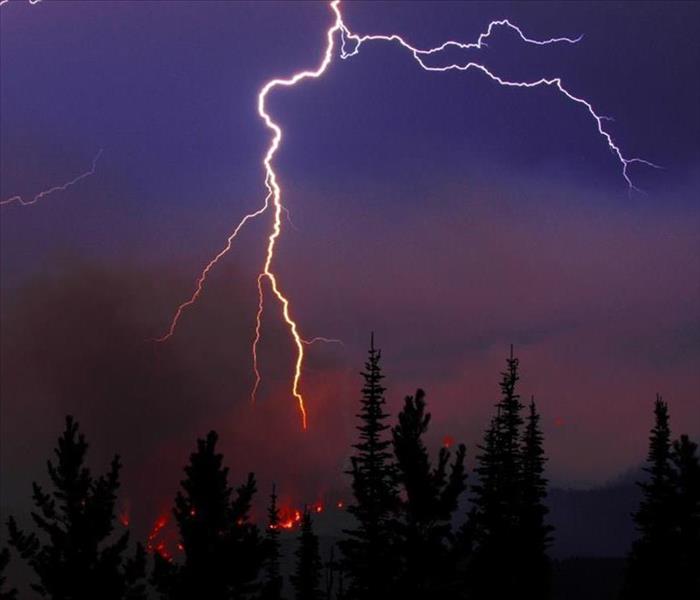 When lightning strikes near a power line, it increases the electrical current. The extra burst of electricity can lead to computer & appliance damage.
When lightning strikes near a power line, it increases the electrical current. The extra burst of electricity can lead to computer & appliance damage.
Did you know that 50% of businesses never reopen after a fire or water disaster? SERVPRO of Portage County is available 24 hours a day to get YOUR business back up and running, "Like it never even happened."
Thunderstorms are absolutely something to be conscious for. 6.5% of all property claims are due to lightning strikes. Wood and other flammable building materials can easily be ignited when lightning comes in contact or passes through them. In addition, high winds, heavy rain and flooding from a thunderstorm can destroy a business in minutes.
If not prepared for a quick recovery, the lost revenue of your business could mean closure.
That is why SERVPRO has local franchises across the nation. When an emergency situation arises, call one of our highly trained professionals, certified in water, fire and mold clean up and restoration.
SERVPRO of Portage County can provide:
- Over 40 years of experience as leading fire and water cleanup and restoration providers.
- There are over 1,500 franchises servicing 48 states.
- More locations for faster responses.
- Quick response time to help ensure the damage is contained and the restoration process begins promptly.
- Large loss capabilities - no fire or water damage is too big.
When the next storm hits Portage County, Ohio, call the professionals at SERVPRO of Portage County - 330-677-4483, or Request Help Online.
Also consider joining our Emergency Ready Program and reduce business interruption following a disaster. Call for details.
Is Your Business Ready?
2/20/2018 (Permalink)
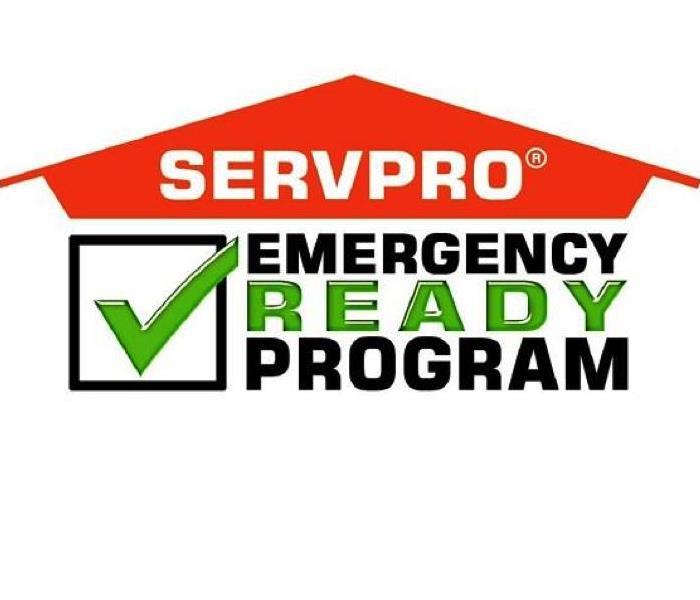 When disaster strikes, getting help is now quicker and easier using the SERVPRO Ready Plan.
When disaster strikes, getting help is now quicker and easier using the SERVPRO Ready Plan.
The best way to reduce business interruption following a disaster is to PLAN for it NOW.
The statistics uncovered by industry research say as many as 50% of businesses may never recover following a disaster. Of the businesses that survive, the majority had a preparedness plan in place.
SERVPRO's Emergency Ready Profile for YOUR business will minimize business interruption by having an immediate plan of action. With a no cost assessment of your facility, the program's profile includes your emergency contacts, all shut off valves and their locations, priority areas of your facility and more.
The SERVPRO Ready Plan provides solutions in advance of an emergency so that during the emergency you are "Ready for whatever happens."
Your business will receive the benefit of over 40 years of experience in reducing the impact of any natural or man-made disaster. Call now and take the next step in protecting and growing your business.
SERVPRO of Portage County - 800-648-1212
And now with the SERVPRO Ready Plan Mobile App, help is at your fingertips. Call now and ask how to get started.
Agents: Watch Word Choice in Claims Letters
10/31/2017 (Permalink)
 Grammar matters.
Grammar matters.
The following bullets point out random errors in word choice. You may not lose a client because you make a poor word choice, but you’re not helping the relationship either. Here are several word choice issues to watch for as you phrase your letters:
- “ABC Insurance Company will make no voluntary payment of your claim…” Voluntary?
- "e.g., and i.e.," most people don’t know the difference. Use e.g., when you are giving examples; use i.e., to introduce your thought “in other words.”
- “Exception” and “exclusion” are words that have their own meanings. One adjuster wrote,” the exception that pertains to your loss can be found in your policy and is provided below for your reference. I think the word should be “exclusion.”
Here’s the difference: An insurance policy tells you what is covered.
Exclusions are classes of items that are not covered, such as nuclear war, acts of God, or terrorism. Exceptions are “exclusions to the exclusions, reinstating particular items within a whole category that had been “excluded.” For example, a homeowner’s policy may have an exclusion for all motorized vehicles. The exception to that exclusion might be a lawnmower, because a mower helps service the premises.
- “Said” – Very legalistic: “Said payment would allow you a discount of $300.” Just write, “This payment would allow you a discount of $300.”
- “Regard” and “Regards.” Do not write, “This is in regards to…” Write, “This is in regard to…”
- “Were” and “was.” Take the phrase, “If there were no coverage…” Using “were,” known as the subjunctive mood in English, represents situations contrary to fact.
- “Confirm.” When you confirm a lunch date, you restate your agreement as to the time and place. In insurance, however, it’s common to see a claims letter that starts, “This will confirm my phone call of 4/11/17." But what does “confirm” mean? Is the writer summarizing the previous call? Documenting it? Confirming is something you do to re-check a future date or agreement.
- “Advise.” About 80 percent of the time claims people use “advise,” they just mean “tell” or “inform.” No need to use “advise” in a sentence like, “Let me advise you that it will rain today.” There is no “advice” being given. However, if you write, “Let me advise you to bring your umbrella,” you are using “advise” correctly.
"Your grammar is a reflection of your image. Good or bad, you have made an impression, and like all impressions, you are in total control." -Jeffrey Gitomer
Defending Your Family Business Against Fraud
10/26/2017 (Permalink)
 Fraud can occur anywhere within a company and the right controls can limit its successful execution.
Fraud can occur anywhere within a company and the right controls can limit its successful execution.
In a study done by the Association of Certified Fraud Examiners (ACFE), the 2016 Global Fraud Study found that "businesses with fewer than 100 employees, which are in many cases family-owned, experience fraud at a rate of 28.8%, compared to the 19.8% experienced by those with more than 10,000 employees."
Smaller business often suffer more from fraudulent activities. It's more difficult to manage the damage it causes in a $5 million company than a $250 million company. This kind of activity also damages the company culture.
The median fraudulent loss suffered by small organizations is the same as large organizations: $150,000. However, while it is the same number, this number takes up a larger percentage of the small business revenue.
Here are 5 ways to defend your small business from fraudulent activities and enforce internal controls:
- Segregate financial duties. Create a three-person system of checks and balances: one person opens the bank statements, one prepares the bank reconciliations, and a third reviews all transactions and canceled checks.
- Stay away from signature stamps. Family and small businesses should require two signatures for any payment over a certain monetary amount.
- Establish routine checks of payroll, supplier and vendor lists by multiple people within the company. The final payroll list should be reviewed by someone other than the person distributing checks and preparing the payroll, and the list of vendors should periodically be checked for unrecognized names.
- Educate employees on financial reporting. To increase levels of security, outsource your financial reporting and ensure someone is monitoring for fraud.
- Every employee — including family members — should understand protocols in a business from expectations to pay rates and benefits. Clear expectations help avoid a power struggle and will clearly define who is double-checking various aspects of the business.
Fraud can happen anywhere. The more you believe it won't happen to your business, the more susceptible you become to it.
Source: 5 Ways to Defend Your Family Business Against Fraud by Bill Kowalski
Hotel Chain Suffers Water Loss: What Will the Carrier Pay?
9/6/2017 (Permalink)
 The extent of the destruction will be the most determining factor when calculating price. Most restoration companies bill by the square foot.
The extent of the destruction will be the most determining factor when calculating price. Most restoration companies bill by the square foot.
Inside a Property Casualty article discussing property damage repairs and what the carrier will cover in replacement costs, there is a question regarding a water loss at a hotel chain with a replacement cost policy. Read below:
Question: Our insured is a hotel that suffered water damage to some of its rooms. The insured is a franchisee and has an agreement with the hotel chain that requires replacement of damaged decor with current decor; all of the rooms on the same floor must be updated to the current decor. The hotel has a replacement cost policy, but the other furniture was not damaged. The carrier's position is that it is not responsible for the non-damaged rooms. What should the carrier pay?
Answer: This scenario differs from the matching issue, about which we often receive questions. The carrier is correct in not paying to bring all of the rooms up to the current decor. There is no loss or damage to the other rooms, and while the rooms would not match each other, this is not something that would be apparent to guests. Nothing in the self-contained rooms themselves would be mismatched.
If the chain requires franchisees to maintain a uniform look to all rooms on a floor, that falls more under the cost of doing business. If the rooms themselves are not damaged, it is not an insurance matter to bring them up to speed with the other rooms.
If items in the rooms themselves are not matched, that would be a different matter. For instance, if a headboard needed to be replaced on one bed but a matching one could not be found, then both headboards should be replaced.
Does your commercial property have water damage? Call our 24/7 Emergency Service number, 330-677-4483, or ask for help online.
Read more on our Commercial Restoration Services.
Winter is Coming: Prepare Your Business for Winter
9/5/2017 (Permalink)
 A winter storm can bring with it sleet, ice, high winds, and heavy snow, which can result in sudden unexpected commercial property damage.
A winter storm can bring with it sleet, ice, high winds, and heavy snow, which can result in sudden unexpected commercial property damage.
September has arrived and before we know it so will Halloween, then Thanksgiving, then the holidays. Is your business ready for the frigid temperatures, the heavy snowfall?
According to Leavitt Group's article, Prepare Your Business for Winter Weather, In the past five years, 15 percent of small businesses have experienced damages caused by water and freezing. The average cost of these claims is $17,000.
Leavitt Group also discusses common types of winter-related damages, including:
- Damage to contents, inventory and equipment caused by significant temperature changes.
- Water damage caused by pipes freezing and bursting.
- Wind damage to roofs, buildings and landscape.
- Fire suppression efforts delayed by inaccessible fire hydrants (covered by snow or ice)
- Frozen fire suppression sprinkler pipes, resulting in flooded rooms and malfunction of system.
- Ice damming, resulting in damage to roof and gutters.
- Injury to guests and employees.
- Loss of revenue (business interruption).
Taking preventative actions now while the weather is still warm is incredibly important and could save you business a lot of time and money. Here are some maintenance tips Leavitt Group suggests in preparing your business for winter:
- Drain water from all systems and equipment not needed in winter months, including landscape sprinklers and air conditioning units
- Check for and repair damages to the roof. Make sure roof drains are clear and in good condition. Clear rain gutters to ensure proper drainage and make sure downspouts are intact and draining in areas away from foot traffic
- Inspect the exterior of the building for gaps and seal appropriately to prevent weather and critters from getting inside
- Trim tree branches and lanscape that might come in contact with the building in the event of heavy snowfall and ice accumulation
- Make sure the heating system has enough fuel for unexpected conditions and a back-up in case of emergency
- Maintain a temperature of at least 45 degrees Fahrenheit in unoccupied facilities, attics and basements
- Make arrangements for snow removal with a reputable company before winter starts- don't wait until the storm hits and you are buried under a pile of snow. Discuss snow removal from the roof. To avoid damages from snow removal equipment, mark curbs, fire hydrants, drains, speed bumps and other features that may not be visible under a layer of snow
- Make sure you have sand, ice melt and shovels on hand for winter maintenance that won't be covered by your snow removal contractor
Begin checking off your maintenance needs while the weather still allows for it. Stay tuned for our next blog for commercial property owners, "Developing a Business Continuity Plan for the Winter Weather."
Have questions? Call our office at 800-648-1212 or our 24/7 Emergency Service number at 330-677-4483.
Cybercrime From An Insurance Perspective
9/1/2017 (Permalink)
 MyDoom is considered the most expensive virus in the world and in cyber security history, having caused an estimated financial damage of $38.5B.
MyDoom is considered the most expensive virus in the world and in cyber security history, having caused an estimated financial damage of $38.5B.
We've heard the stories. Cyber hacks influencing the presidential election, ransomware attacks across the globe. We might even think the hackers are winning the war- the cyber war, that is.
Insurance Business America discusses this matter with an insurance perspective in a recent article, interviewing James Shaheen, cyber risk practice leader at Integro.
According to Shaheen, with every attack, our cyber security experts learn something new, and counter every attack with a defense. It will take us some time, though, to figure out what we need to implement, where the gaps are in the security, to fully protect our data.
When it comes to insurance, Shaheen believes we are doing well in the protection of Protected Health Information (PHI), Personally Identifiable Information (PII) and the Payment Card Industry (PCI), but the concern is what he calls "second-tier data."
Second-tier data, or trade secrets, is what drives businesses, and is also what is not well protected by insurance from these cyber attacks.
Shaheen claims at Integro this is an issue being addressed and developed. How much would such a development be worth to your business?
To read Insurance Business America's article and for related stories, click here.
Creating a Killer Facebook Ad Campaign for Your Business
9/1/2017 (Permalink)
Marketing on Facebook doesn't have to be confusing and intimidating. Here are some things to consider when developing your Facebook Ad campaign, a simple and straightforward strategy that will expose your message to your ideal market and present a relevant message that drives prospects to take action:
- Target your audience. Identify your ideal client, find people who had had “liked” groups related to the subject, target a specific ZIP code or individuals who fall between certain ages. Facebook allows you to filter these and more demographics.
- The ideal budget. Facebook allows you to start your campaign budget at $5. As you progress, so can your investment.
- The perfect Facebook Ad. What should it look like?
- Don't mention pricing. Studies show that ads without price have 10% higher conversion rates.
- Add a face to the ad.
- Choose images that show the desired result of your clients, where they will be after your work.
- Test Red vs. Blue. Studies also show ads with red and blue have 20% higher conversion and click-through rates.
- Use a "call to action" button, such as "Apply Now."
- Where should the clicks go? You do not want to send your prospects to the home page of your website. Direct your traffic to a landing page where they can download a report, where the only action they can take is the next step in the process.
For details and graphics on this subject, click here to read the main article.
Restoring Your Portage County Commercial Property After A Water Damage Event
10/13/2016 (Permalink)
 Commercial Water Damage Events Present Unique Challenges
Commercial Water Damage Events Present Unique Challenges
Flooding and water damage events at Portage County commercial properties are often complex with numerous issues that require a knowledgeable and flexible response. Whether we’re dealing with a relatively small water cleanup scenario or a large scale event, we work quickly to assess each unique situation and isolate the damaged area. In many instances, normal operations can continue in a temporary space while we restore your facility.
Restoring Commercial Properties Presents Unique Challenges
Our professionals are trained to be mindful of legal and environmental concerns and strive to fully restore the damaged area while working within your budgetary constraints. We understand that every hour spent cleaning up is an hour of lost revenue and productivity. So when an emergency situation arises in your business, give us a call and we’ll be there fast with the help you need.






 24/7 Emergency Service
24/7 Emergency Service
